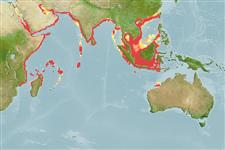Common names from other countries
Environment: milieu / climate zone / depth range / distribution range
Ecología
; rango de profundidad 9 - 160 m (Ref. 103583). Tropical; 31°N - 19°S, 32°E - 121°E (Ref. 1695)
Distribución
Países | Áreas FAO | Ecosistemas | Ocurrencias, apariciones | Introducciones
Indo-West Pacific: from Indian Ocean to Indonesia and southern South China Sea.
Length at first maturity / Tamaño / Peso / Age
Maturity: Lm 6.1 range ? - ? cm Max length : 12.5 cm ML macho / no sexado; (Ref. 275)
Females grow larger than males (Ref. 3722). Feeds on small demersal fishes, crustaceans, other cephalopods (Ref. 275).
Life cycle and mating behavior
Madurez | Reproducción | Puesta | Huevos | Fecundidad | Larva
Members of the class Cephalopoda are gonochoric. Male and female adults usually die shortly after spawning and brooding, respectively. Mating behavior: Males perform various displays to attract potential females for copulation. During copulation, male grasp the female and inserts the hectocotylus into the female's mantle cavity where fertilization usually occurs. Life cycle: Embryos hatch into planktonic stage and live for some time before they grow larger and take up a benthic existence as adults.
Jereb, P. and C.F.E. Roper (eds.). 2005. (Ref. 1695)
IUCN Red List Status (Ref. 130435)
CITES status (Ref. 108899)
Not Evaluated
Not Evaluated
Human uses
Pesquerías: comercial
| FishSource |
Herramientas
Fuentes de Internet
Estimates based on models
Preferred temperature
(Ref.
115969): 22.5 - 28.6, mean 27.3 (based on 743 cells).
Resiliencia
Alto, población duplicada en un tiempo mínimo inferior a 15 meses (K=0.52-2.25).
Vulnerability
Low vulnerability (10 of 100).
